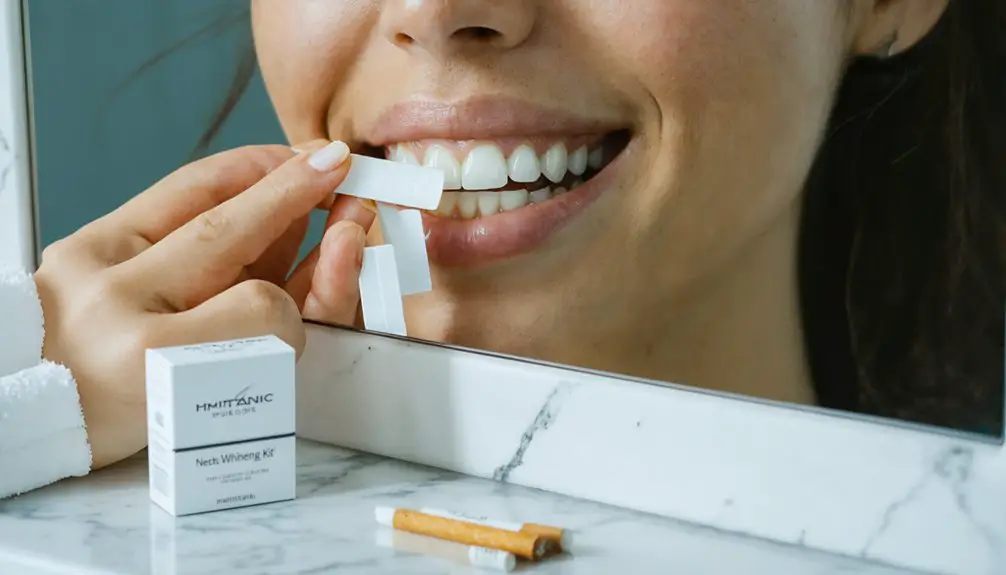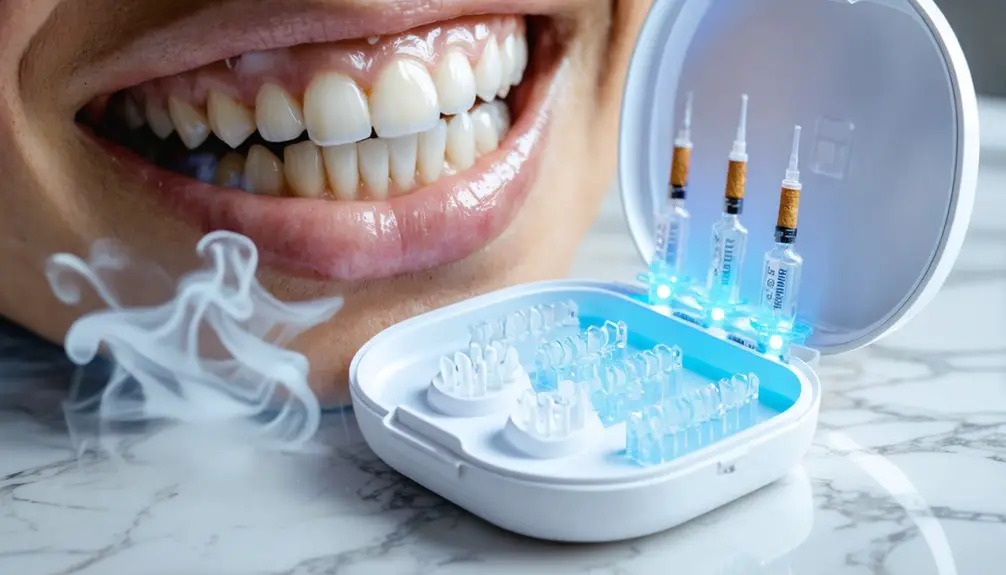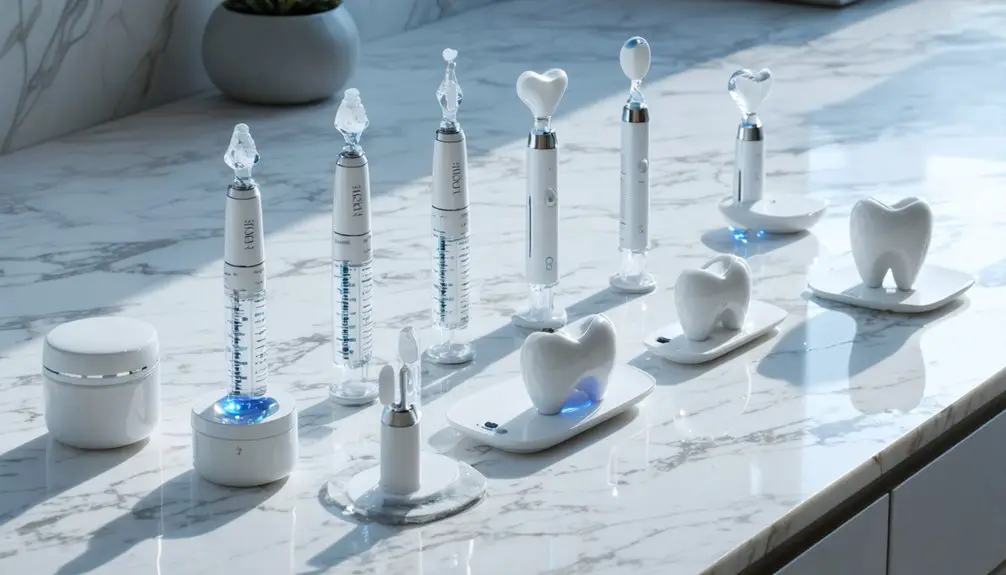Home teeth whitening kits can effectively combat your tobacco-stained teeth through active peroxide compounds that break down both surface and deep stains. The kits work by releasing oxygen molecules that disrupt the chemical bonds in nicotine and tar deposits, while specialized surfactants help loosen trapped staining particles. You’ll typically need multiple applications and longer treatment periods compared to non-smokers, but consistent use can deliver noticeable results. Understanding the science behind these treatments will help maximize your whitening success.
Key Takeaways
- Peroxide-based whitening agents break down nicotine’s yellow compounds and disrupt chemical bonds in tobacco stains through reactive oxygen molecules.
- Surfactants in whitening kits help loosen tar matrices where nicotine becomes trapped, allowing better penetration of whitening agents.
- Home kits containing 10-22% carbamide peroxide effectively whiten smokers’ teeth through multiple applications over extended treatment periods.
- Small whitening gel molecules can penetrate enamel’s porous structure to address both surface and internal tobacco staining.
- Regular use of home whitening kits, combined with proper oral care, helps combat continuous staining from smoking.
The Science Behind Tobacco Stains on Teeth
While many smokers understand that tobacco causes teeth staining, the chemical processes behind this discoloration are quite complex.
When you smoke, your teeth encounter two primary staining agents from tobacco composition: tar and nicotine. Tar, naturally dark and sticky, adheres to your tooth enamel, while nicotine, initially colorless, turns yellow when exposed to oxygen. The buildup of these substances results in deep yellowing stains.
Tobacco’s double assault on tooth color comes from sticky tar deposits and nicotine that yellows upon contact with oxygen.
These compounds don’t just sit on the surface – they penetrate deep into your tooth structure, creating both surface (extrinsic) and internal (intrinsic) stains.
What makes stain prevention particularly challenging is that smoking reduces your saliva flow, limiting your mouth’s natural cleaning ability. The combination of decreased saliva, sticky tar deposits, and oxidized nicotine creates perfect conditions for persistent tooth discoloration that becomes more difficult to remove over time. Individuals who smoke regularly face higher oral health risks beyond just cosmetic concerns.
Understanding Peroxide-Based Whitening Agents
Because peroxide-based whitening agents form the backbone of effective home teeth whitening, it’s crucial to understand how they work against tobacco stains.
When you use a home whitening kit, you’re typically applying carbamide peroxide at concentrations between 10% and 22%, which gradually breaks down into hydrogen peroxide. This controlled release guarantees ideal peroxide potency while maintaining safety for your teeth.
The whitening duration depends on how these compounds penetrate your enamel and attack tobacco stains. As the peroxide breaks down, it releases reactive oxygen molecules that disrupt the chemical bonds in stain particles. Due to smoking’s oral effects, users may need additional treatment sessions for optimal results.
You’ll find this process particularly effective against nicotine and tar discoloration, as the slow-release formula allows for deeper penetration into your tooth structure, though continued smoking can compromise your results. Regular dental cleanings help maintain and enhance the effectiveness of home whitening treatments.
How Home Kits Break Down Nicotine Stains
Since nicotine oxidizes upon exposure to oxygen, it forms stubborn yellow compounds that bond tightly to your teeth’s enamel and dentin surfaces.
Home whitening kits contain specialized agents that initiate chemical breakdown of these oxidized compounds into smaller, less pigmented molecules, weakening their grip on your teeth. Your teeth’s porous enamel absorbs both stains and whitening agents through microscopic channels.
The kits work through multiple mechanisms to achieve effective stain removal. They contain surfactants that help loosen the tar matrix where nicotine gets trapped, while small molecules in the whitening gels penetrate deep into your enamel’s porous structure. Research shows smokers face 2.4 times higher risk of severe tooth discoloration compared to non-smokers.
These components reach intrinsic stains embedded within your tooth structure. Additionally, the kits include compounds that neutralize stain precursors and prevent re-staining, while moisturizing agents mimic saliva’s natural cleansing function, optimizing the overall whitening process.
Realistic Expectations for Smokers Using Home Kits
If you’re a smoker using home whitening kits, you’ll need to commit to longer treatment periods and multiple applications to achieve noticeable results, as nicotine stains are particularly resistant to bleaching agents.
Studies show that using 22% carbamide peroxide for daily one-hour treatments can effectively whiten teeth for smokers, though results vary between individuals.
You can expect stains to return more quickly than they’d for non-smokers, requiring consistent maintenance treatments every few months to preserve whitening effects.
While home kits can produce visible improvements, they typically won’t match the dramatic results of professional treatments, especially given smoking’s ongoing impact on tooth discoloration.
Brushing and rinsing immediately after smoking can help minimize new stains while using home whitening kits.
Time and Results Required
While non-smokers can achieve whiter teeth relatively quickly with home kits, smokers need to adjust their expectations greatly. The treatment duration for tobacco-stained teeth typically extends over several weeks to months of consistent use before visible results emerge.
- You’ll need to apply whitening gel daily for 2-4 weeks, spending 30-60 minutes per session to see gradual improvements in tooth color.
- Due to deep nicotine staining, you may achieve partial rather than complete whitening, especially if you continue smoking during treatment.
- Your results will depend heavily on maintaining a consistent application schedule, as gaps in treatment can greatly reduce effectiveness and allow new stains to develop.
Smokers often experience reduced saliva production which can make teeth more vulnerable to staining during the whitening process. Remember that sensitivity may require you to adjust your treatment frequency, potentially extending the overall timeline for achieving your desired results. Professional consultation is recommended since underlying oral health issues could affect the whitening process.
Managing Stain Reoccurrence
Because nicotine and tar from tobacco smoke quickly redeposit on teeth, smokers face unique challenges in maintaining their whitening results.
You’ll need to focus heavily on stain prevention and consistent oral care to extend the effects of your home whitening treatments.
To maximize your results, implement a thorough maintenance strategy. Use whitening toothpaste daily, maintain diligent brushing and flossing habits, and consider an anti-staining mouth rinse.
Schedule regular professional cleanings to remove deep-set stains and tartar buildup. It’s crucial to understand that you’ll likely require more frequent touch-ups with your home whitening kit compared to non-smokers.
For best outcomes, avoid smoking immediately after whitening sessions, and consider reducing tobacco use, as this directly impacts how long your results will last.
Limitations Vs Professional Treatment
Although home whitening kits offer a convenient and affordable option for smokers, they come with notable limitations compared to professional treatments. Understanding these differences will help you set realistic expectations for your whitening journey.
- Home kit effectiveness is limited by lower peroxide concentrations, making them less powerful against deep tobacco stains and requiring longer treatment periods for visible results.
- Professional treatment benefits include higher-strength whitening agents, specialized light activation, and expert supervision to maximize results while minimizing sensitivity risks.
- If you’re a heavy smoker with significant staining, you’ll find that professional treatments deliver more dramatic, immediate improvements, while home kits typically only address mild to moderate discoloration and may require multiple applications for noticeable change.
Best Practices for Maximum Whitening Results
To achieve ideal whitening results with your home kit, you’ll need to follow proper application techniques including consistent daily use, precise gel measurements, and careful tray placement.
You’ll maximize long-term success by maintaining excellent oral hygiene, avoiding tobacco products during treatment, and scheduling professional cleanings before starting the whitening process.
After completing your initial whitening treatment, you can preserve your brighter smile through periodic touch-up sessions, limiting staining substances, and continuing rigorous dental care routines.
Proper Application Steps
Achieving ideal results with home teeth whitening kits requires careful attention to proper application steps, particularly for smokers dealing with stubborn stains. The key to success lies in meticulous preparation and precise gel application techniques to maximize effectiveness while minimizing sensitivity.
- Begin by thoroughly cleaning your teeth and flossing to remove plaque buildup that could interfere with the whitening agent’s penetration into your enamel.
- Guarantee proper tray fitting by following manufacturer instructions carefully, then apply a thin, even layer of whitening gel without overfilling to prevent gum irritation.
- Wear the trays for the recommended duration, typically 30 minutes to 2 hours daily, and maintain consistency in your treatment schedule while avoiding staining substances during the whitening period.
Maintaining Long-Term Results
While smokers face unique challenges in maintaining their teeth whitening results, several proven strategies can help preserve that brighter smile for longer periods.
The most effective approach combines professional dental care with consistent at-home maintenance. You’ll need to schedule bi-yearly cleanings and use whitening toothpaste daily to combat recurring stains.
Consider dietary changes by limiting staining beverages and foods, while increasing your water intake to rinse away harmful substances.
For ideal long-term success, smoking cessation remains the most vital step. Until then, use professional whitening trays for touch-ups and maintain a thorough oral hygiene routine with fluoride toothpaste and antiseptic mouthwash.
Regular dental check-ups will help monitor your progress and allow for timely adjustments to your whitening strategy.
Professional vs. Home Whitening for Tobacco Users

Since professional and at-home whitening treatments offer distinct approaches for tobacco users, understanding their key differences is essential for making an informed choice.
Professional treatment benefits include stronger bleaching agents, customized approaches, and faster results, especially for deep-set tobacco stains. Home kit advantages focus on convenience, affordability, and flexibility in treatment timing.
- Professional whitening delivers dramatic results in fewer sessions through concentrated hydrogen peroxide and potential laser activation, though at a higher cost.
- At-home kits provide gradual improvement through lower-concentration gels and multiple applications, making them ideal for maintenance.
- You’ll find that combining both methods – starting with professional treatment followed by at-home maintenance – often yields the best long-term results for tobacco users while balancing effectiveness and cost.
Safety Considerations for Smokers’ Teeth
Before starting any teeth whitening regimen, smokers must understand the unique safety challenges they face. Your compromised gum health and increased smoker sensitivity require extra precautions when using whitening products.
To protect your weakened enamel protection, choose kits with lower peroxide concentrations to minimize potential tissue irritation and adverse reactions.
You’ll need to be especially mindful of exposed tooth roots from gum recession, as these areas won’t respond to whitening treatments and may become more sensitive.
The combination of smoking-related chemical changes and bleaching agents can increase cytotoxic effects, so strictly follow application instructions.
Consider consulting your dentist first to assess your oral health status and determine if your gums and enamel can safely tolerate home whitening procedures.
Maintaining White Teeth While Smoking

How can smokers maintain their teeth’s whiteness after investing in whitening treatments? While smoking creates significant whitening barriers, you can protect your investment through consistent oral care and lifestyle adjustments. Regular dental visits and professional cleanings are essential for monitoring stain progression and maintaining results.
- Brush immediately after smoking, use whitening toothpaste designed for tobacco stains, and rinse with water or mouthwash to minimize nicotine deposits.
- Reduce exposure to staining agents by using straws for dark beverages, limiting acidic foods, and drinking water frequently throughout the day.
- Consider smoking alternatives or gradual reduction while using custom whitening trays under professional supervision to maintain results.
Your dentist can create a personalized maintenance plan combining in-office treatments with at-home care to combat persistent tobacco discoloration effectively.
Key Ingredients in Effective Home Whitening Kits
When you’re selecting a home whitening kit to combat tobacco stains, you’ll find that hydrogen peroxide and carbamide peroxide are the primary active ingredients, typically available in concentrations between 3-10% for safe yet effective results.
These peroxide-based whitening agents work by penetrating your tooth enamel and breaking down organic stain molecules through oxidation, specifically targeting discoloration caused by smoking.
The chemistry behind these whitening agents allows them to tackle both surface stains and deeper discoloration, with consistent use showing visible results within 1-2 weeks for most smokers.
Peroxide Types and Concentrations
Understanding the types and concentrations of peroxide in teeth whitening kits is essential for achieving effective results, especially for smokers dealing with stubborn stains. The two main types you’ll encounter are hydrogen peroxide and carbamide peroxide, each offering different benefits for peroxide stability and whitening effectiveness.
- Hydrogen peroxide acts as the primary active whitening agent, with professional treatments using concentrations up to 40%, while home kits typically contain up to 10%.
- Carbamide peroxide offers greater stability and longer shelf life, breaking down into hydrogen peroxide at a 3:1 ratio – meaning 15% carbamide equals about 5% hydrogen peroxide.
- For smokers, higher concentrations may be necessary, but you’ll need to stay within legal limits – up to 6% hydrogen peroxide in Europe and 15% carbamide peroxide in the US for over-the-counter products.
Active Whitening Agent Chemistry
The chemistry behind teeth whitening agents revolves around powerful oxygen radicals that target stubborn smoking stains. When you use home whitening products, carbamide peroxide breaks down into hydrogen peroxide, releasing these oxygen radicals that penetrate your enamel and break apart tar and nicotine deposits through oxidation.
The active ingredient effectiveness depends on proper chemical stability analysis during formulation. Manufacturers carefully control pH levels and add stabilizers to maintain peroxide integrity, ensuring consistent whitening power throughout your treatment.
The formulas often include desensitizing agents like potassium nitrate and anti-inflammatory compounds to protect your gums and reduce sensitivity. Custom delivery systems, such as fitted trays or strips, maximize contact time between the whitening agents and your teeth, allowing deeper penetration for better results against smoking-related discoloration.
Surface Stain Breaking Power
Powerful home whitening kits rely on a sophisticated combination of mechanical and chemical agents to break down stubborn tobacco stains.
You’ll find carefully balanced formulations that maximize abrasive effectiveness while protecting your enamel from damage. The synergistic action of multiple ingredients targets both surface and embedded stains from smoking.
- Silica and calcium carbonate provide mechanical scrubbing power to lift away tar deposits, while enzymatic action from ingredients like papain breaks down organic stain compounds.
- Surfactants reduce surface tension, allowing deeper penetration into enamel micro-porosities where nicotine stains hide.
- Dual-action formulas combine lipophilic agents to dissolve tar-based stains with hydrophilic components that help disperse them into saliva for easy removal.
Essential Oral Care During Whitening Treatment
Maintaining proper oral care during teeth whitening treatment becomes especially essential for smokers who face unique challenges in their pursuit of a brighter smile.
You’ll need to focus on consistent whitening maintenance while managing sensitivity that can be heightened by smoking. Use a soft-bristled toothbrush and non-abrasive toothpaste to protect your enamel, and incorporate an antimicrobial mouthwash to support gum health during treatment.
To minimize discomfort, apply desensitizing toothpaste containing potassium nitrate before and after whitening sessions. Stay well-hydrated and consume calcium-rich foods to strengthen your enamel.
You’ll also want to avoid acidic foods and dark beverages during treatment. If you experience prolonged sensitivity, don’t hesitate to consult your dentist, who can adjust your whitening routine and provide personalized care recommendations.
Frequently Asked Questions
Can Whitening Kits Remove Yellow Stains From Vaping and E-Cigarettes?
You’ll find whitening kits can effectively remove vaping-related yellow stains through oxidation, though you’ll need consistent treatment since ongoing vaping effects can lead to repeated stain formation on teeth.
How Long Should Smokers Wait After Quitting Before Starting Teeth Whitening Treatment?
Plan your perfect path: wait 2-4 weeks after smoking cessation before whitening your teeth. This allows gums to heal, reduces teeth sensitivity risks, and improves your treatment’s long-term effectiveness.
Do Whitening Strips Work Differently on Menthol Cigarette Stains Versus Regular?
You won’t see significant differences in menthol stain removal versus regular cigarette residue effects. Whitening strips work similarly on both types, though menthol smokers may need longer treatment due to deeper staining.
Can Teeth Whitening Kits Damage Existing Dental Fillings or Crowns?
While whitening kits won’t chemically damage your fillings or crowns, they can temporarily affect filling sensitivity. Your crown longevity isn’t impacted, but surrounding natural teeth may whiten unevenly, causing color mismatches.
Should Smokers Use Special Toothpaste While Doing Home Teeth Whitening Treatments?
You don’t need special toothpaste during whitening treatments, as smoker sensitivity isn’t higher than non-smokers. Regular fluoride toothpaste works well, though desensitizing toothpaste can help if you experience discomfort.
References
- https://friedmandentalgroup.com/dental-related/teeth-whitening-for-smokers-solutions-to-remove-tobacco-stains/
- https://www.natrusmile.com/blogs/news/teeth-whitening-for-smokers
- https://smilepath.com.au/blogs/blog/ultimate-guide-to-teeth-whitening-for-smokers
- https://custmbite.com/pages/how-smokers-can-get-whiter-teeth
- https://healthcare.utah.edu/the-scope/health-library/all/2023/10/does-home-teeth-whitening-really-work
- https://rontostodds.com/blog/teeth-whitening-for-smokers-addressing-stains-from-tobacco-use/
- https://beyonddentalgb.com/why-does-smoking-or-vaping-stain-teeth/
- https://www.greentreedentalgroup.com/articles/tobacco-stains-on-teeth-a-comprehensive-guide
- https://pmc.ncbi.nlm.nih.gov/articles/PMC9932248/
- https://legacydental.com/blog/intrinsic-tooth-stains-causes-treatments/



